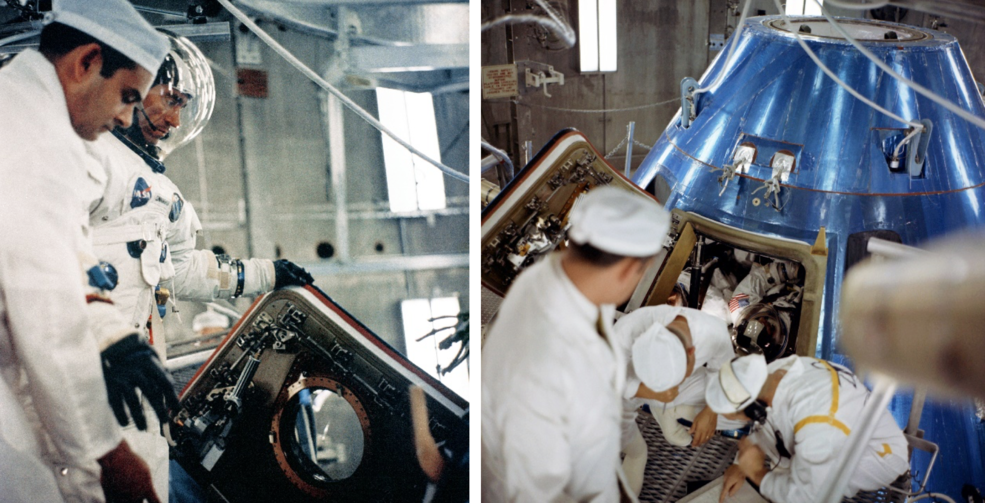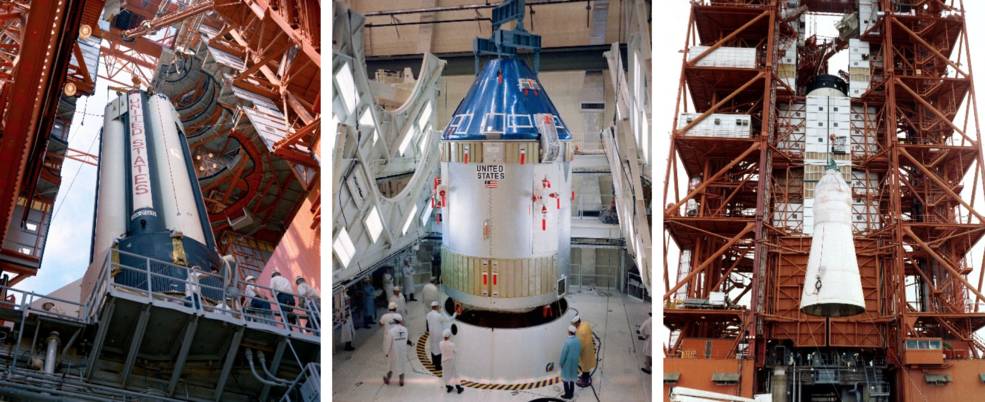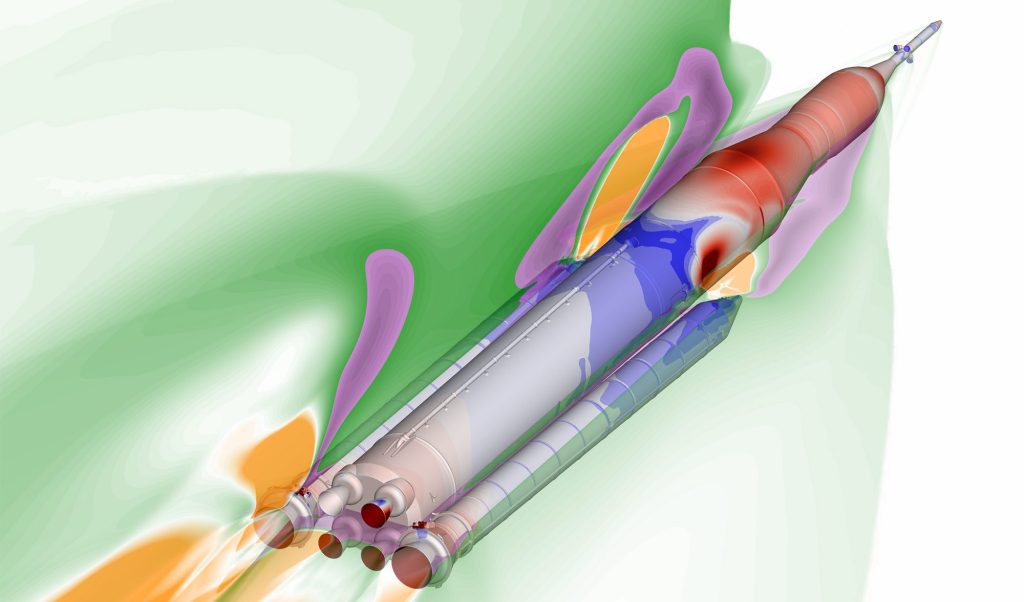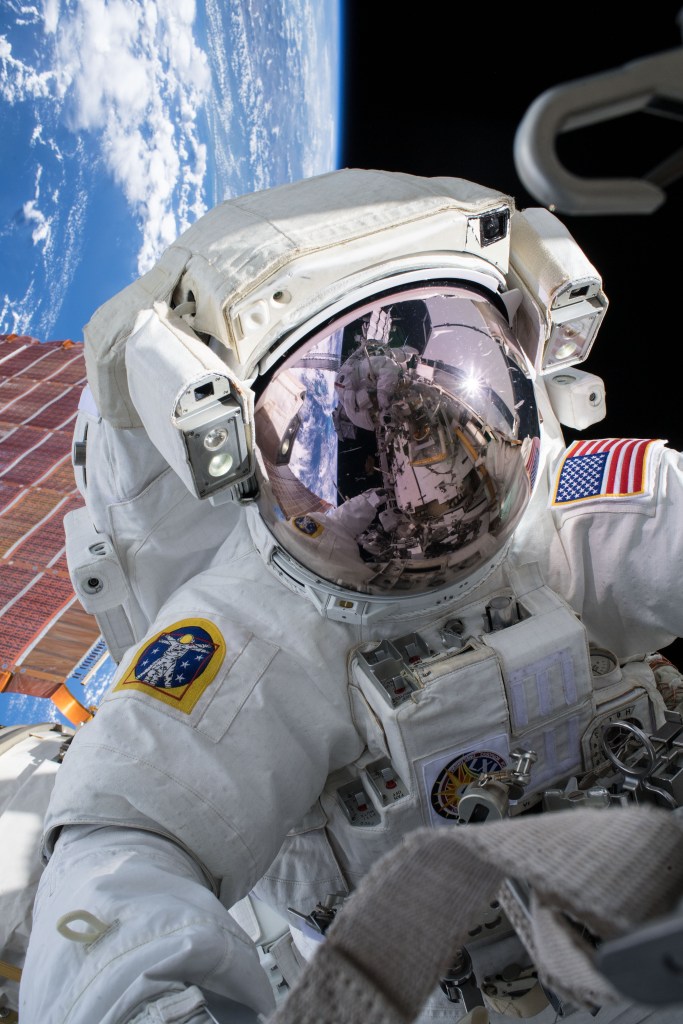In the summer of 1968, NASA was preparing for the first crewed Apollo mission. Apollo 7, scheduled for launch in October, was the first American crewed flight since Gemini 12 in November 1966, and marked a resumption of human space flights halted by the Apollo fire in January 1967. As a result of the accident, NASA redesigned the Apollo spacecraft to minimize flammability in the space capsule. This included replacing many components with fireproof or fire-retardant materials and changing the cabin’s atmosphere during ground tests. Many other tests ensured that the spacecraft and spacesuits would be ready to safely fly crews in space.
The spacecraft to be flown on Apollo 7, Command and Service Module (CSM) 101, arrived at the Kennedy Space Center (KSC) from its manufacturer North American Rockwell in Downey, California, in May 1968. Engineers conducted several weeks of checkout with the CSM, leading up to tests in KSC’s altitude chamber in late July. The Apollo 7 prime crew, Commander Walter M. Schirra, Command Module Pilot Donn F. Eisele and Lunar Module Pilot R. Walter Cunningham conducted a 9-hour altitude test on July 26, followed by the backup crew of Thomas P. Stafford, John W. Young and Eugene A. Cernan on July 29. According to Schirra, “the major purpose of the tests is to prove out all the spacecraft systems under altitude conditions. The spacecraft, the test team, and we the crew, had a good run.” During the prime crew’s test, they simulated an emergency by depressurizing the capsule. After the test, Schirra commented, “Our confidence in the spacecraft was so high that we were able to vent the cabin and remain for several hours at a high altitude in our pressurized suits, relying solely on the spacecraft systems for support.”
L

Left: Prime crewmember Cunningham about to enter the Command Module for the altitude test. Right: All three crewmembers are in the Command Module for the altitude test.
On August 5, the prime crew donned spacesuits and climbed inside a boilerplate Apollo Command Module aboard MV Retriever in the Gulf of Mexico for water egress training. Technicians from the Landing and Recovery Division of the Manned Spacecraft Center, now the Johnson Space Center in Houston, first lowered the capsule into the water in the nose down position. Uprighting bags inflated and turned the capsule into the nose up position to allow the crew to safely egress from the floating spacecraft. Proving the concept, the crew then opened the hatch and climbed out onto life rafts. The recovery team picked up the astronauts and delivered them back to the Retriever. The backup crew repeated the exercise the following day.
Following the altitude chamber tests, technicians and engineers at KSC began the process of moving the CSM out to Launch Pad 34, where the first and second stages of the Saturn IB had been erected in April 1968. Engineers modified the second stage’s J-2 engine to prevent a recurrence of the problem encountered during the Apollo 6 mission, including strengthening the propellant lines. In early August, technicians mated the CSM to the Spacecraft Lunar Module Adaptor (SLA) in the Manned Spacecraft Operations Building (MSOB), and on August 9, trucked that assemblage out to Pad 34 and lifted it onto the 2-stage Saturn IB for mechanical mating with the rocket. They topped off the rocket with the Launch Escape Tower. Several weeks of integrated launch vehicle testing beginning August 15 led to a 6-day countdown demonstration test in September and the launch of Apollo 7 in October.

Left: First stage of the Saturn IB rocket in place at Launch Pad 34 in April 1968. Middle: Apollo 7 CSM being mated to the SLA in the MSOB. Right: Apollo 7 CSM/SLA being lifted onto Saturn IB at Pad 34.

























